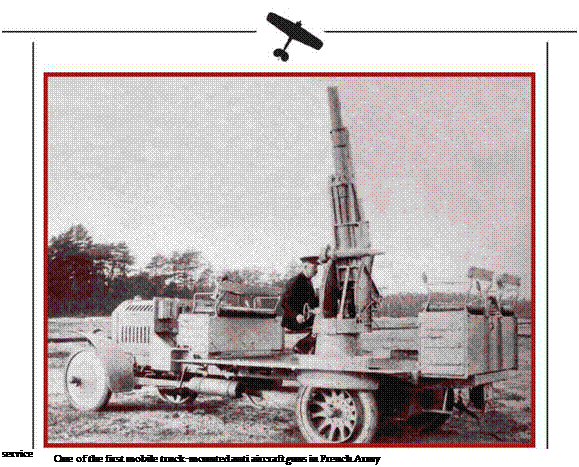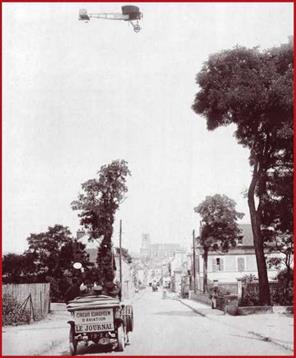EMERGENCE OF AIR DEFENCE. AND AIR DEFENCE TACTICS
|
A |
s the threat from the air grew, states took measures to counter it. However, although air defence developed hand-in-hand with airforces, the idea of uniting the two into a single structure met with no success in peacetime. By late 1905 it was clear that France was assessing seriously the possibility of using airships for military ends. Thus the issue of how to prevent aerial attack from airships acquired primary importance. The very first theoretical ideas hit a completely unexpected obstacle. Initially, it was expected that the artillery would be more effective against airships than the infantry. Germans viewed their 1904 model 100mm howitzer, and the light field howitzer, as particularly suited for the role. Both could adopt the required elevation angle without especial preparations or accessories. Flight altitudes until 1914 rarely exceeded 1200m, which explains why the light field howitzer retained its air defence role despite its indifferent ballistic quality.
It was down to practical experience to show the road ahead. The limited area of land testing grounds pointed the military to the sea, and particularly inland waters. This was helped by large arms manufacturers. In 1911, Germany’s Krupps and the Rhein Machine and Metal Products Factory (‘Rheinmetall’) built a 77mm air defence weapon mounted on a truck, with a special mount being designed for it the following year. After their first test firings, the infantry and cavalry pinned their hopes on massed small arms and machine gun fire directed against aircraft which still flew relatively low and within range of these weapons.
Air defence artillery weapons also found a naval application. Since naval installations were fixed, what counted most was good ballistic properties and increased caliber, hence firepower. The 88mm ship board gun looked most promising because of its high initial velocity and elevation angles of up to 70 degrees. Powerful spotlights were also foreseen against nocturnal attacks.
Realistic combat-condition testing was still a problem. Unmanned target drones were still in the future. The few aeroplanes available were rather too expensive to be wasted in such tests. Pooling the efforts of the various arms under a single command might have resolved many problems, major ones being taking precise aim in a new way, using principally new weapons, and using principally new instrumentation.
France was one of the leaders in air defence technology. There, the 75mm field gun turned out most suitable for firing at airborne targets. It was also to be mounted


I Highly mobile anti aircraft machine gun platforms such as this one entered service with infantry and cavalry units
on a truck later, and by 1914 equipped mobile batteries within several artillery regiments. Combat to come was to show that this was far from adequate.
Other nations failed to create air defence structures until the Great War. Even though the final manoeuvres threw some light on suitable air defence tactics, hard and fast decisions on air defence structures appeared premature. Initially, air defence units were appended to field artillery regiments guarding national borders. Large orders were placed for the reasonably capable mobile artillery weapons.
Anti aircraft artillery tactics aimed to disturb enemy flying. The greater the usefulness of aerial artillery direction and correction, the greater the need to hamper its precision and effectiveness. The necessity of assigning anti aircraft weapons to cavalry corps and divisions became obvious. Tactics used to counter enemy flying, and camouflage as a most effective passive means of air defence were thoroughly overhauled. Less mobile animal-draught artillery units were assigned to protect important targets in the rear. Corps commands which received anti aircraft weapons, machine guns, projectors and communications equipment were advised to act as they saw fit.
The extent of defence afforded depended on target importance. The range of options covered anything from infantry small arms fire to the combined use of rifles, machine guns, field guns and projectors. A communications network began to emerge, to speed the passage of information on enemy aerial movements.
|

>










